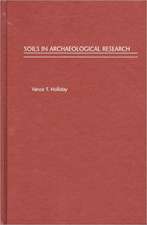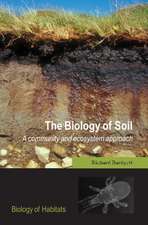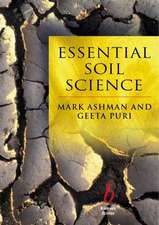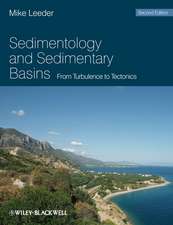Amazonian Dark Earths: Explorations in Space and Time
Editat de Bruno Glaser, William I. Woodsen Limba Engleză Hardback – 12 mai 2004
| Toate formatele și edițiile | Preț | Express |
|---|---|---|
| Paperback (1) | 637.46 lei 6-8 săpt. | |
| Springer Berlin, Heidelberg – 30 noi 2010 | 637.46 lei 6-8 săpt. | |
| Hardback (1) | 644.49 lei 6-8 săpt. | |
| Springer Berlin, Heidelberg – 12 mai 2004 | 644.49 lei 6-8 săpt. |
Preț: 644.49 lei
Preț vechi: 758.23 lei
-15% Nou
Puncte Express: 967
Preț estimativ în valută:
123.33€ • 128.04$ • 102.84£
123.33€ • 128.04$ • 102.84£
Carte tipărită la comandă
Livrare economică 22 martie-05 aprilie
Preluare comenzi: 021 569.72.76
Specificații
ISBN-13: 9783540007548
ISBN-10: 3540007547
Pagini: 232
Ilustrații: XIV, 216 p. 69 illus., 2 illus. in color.
Dimensiuni: 155 x 235 x 20 mm
Greutate: 0.53 kg
Ediția:2004
Editura: Springer Berlin, Heidelberg
Colecția Springer
Locul publicării:Berlin, Heidelberg, Germany
ISBN-10: 3540007547
Pagini: 232
Ilustrații: XIV, 216 p. 69 illus., 2 illus. in color.
Dimensiuni: 155 x 235 x 20 mm
Greutate: 0.53 kg
Ediția:2004
Editura: Springer Berlin, Heidelberg
Colecția Springer
Locul publicării:Berlin, Heidelberg, Germany
Public țintă
Professional/practitionerCuprins
1 Towards an Understanding of Amazonian Dark Earths.- 2 History, Current Knowledge and Future Perspectives of Geoecological Research Concerning the Origin of Amazonian Anthropogenic Dark Earths (Terra Preta).- 3 Evolution of the Scientific Knowledge Regarding Archaeological Black Earths of Amazonia.- 4 A Geographical Method for Anthrosol Characterization in Amazonia: Contributions to Method and Human Ecological Theory.- 5 Paleoriverine Features of the Amazon Lowlands: Human Use of the 'Arena Negra' Soils of Lake Charo, Northeastern Peru.- 6 Dark Earth in the Upper Amazon.- 7 Organic Matter in Archaeological Black Earths and Yellow Latosol in the Caxiuanã, Amazonia, Brazil.- 8 Sequential P Fractionation of Relict Anthropogenic Dark Earths of Amazonia.- 9 The Timing of Terra Preta Formation in the Central Amazon: Archaeological Data from the Three Sites.- 10 Semi-Intensive Pre-European Cultivation and the Origins of Anthropogenic Dark Earths in Amazonia.- 11 Identifying the Pre-Columbian Anthropogenic Input on Present Soil Properties of Amazonian Dark Earths (Terra Preta).- 12 Use of Space and Formation of Terra Preta: The Asurini do Xingu Case Study.- 13 Research on Anthropogenic Dark Earth Soils. Could It Be a Solution for Sustainable Agricultural Development in the Amazon?.- 14 Slash and Char: An Alternative to Slash and Burn Practiced in the Amazon Basin.- 15 Microbial Response to Charcoal Amendments of Highly Weathered Soils and Amazonian Dark Earths in Central Amazonia - Preliminary Results.
Recenzii
From the reviews:
"Concern for the environmental health of Amazonia is at the forefront of current international environmental issues. … Even more uncommonly discussed is the existence of ‘dark earths,’ the subject of this book. … Coverage ranges from a review of the literature to discussion of appropriate methodology. … the book is well written and an excellent resource on this topic. … it will be valuable for all academic libraries and useful to a wide range of readers in natural resources and even in anthropology. Summing Up: Recommended." (M.G. Messina, CHOICE, Vol. 42 (5), January, 2005)
"Concern for the environmental health of Amazonia is at the forefront of current international environmental issues. … Even more uncommonly discussed is the existence of ‘dark earths,’ the subject of this book. … Coverage ranges from a review of the literature to discussion of appropriate methodology. … the book is well written and an excellent resource on this topic. … it will be valuable for all academic libraries and useful to a wide range of readers in natural resources and even in anthropology. Summing Up: Recommended." (M.G. Messina, CHOICE, Vol. 42 (5), January, 2005)
Notă biografică
Dr. Bruno Glaser is Assistant Professor at the Institute of Soil Science and Soil Geography at the University of Bayreuth. For over seven years he has been conducting Amazonian dark earth research from a soil science perspective including soil fertility, sustainability, and archaeology aspects.
Dr. William Woods is Professor in the Department of Geography and Director of the Archaeology Program at Southern Illinois University Edwardsville. For over thirty years he has been conducting prehistoric and historic settlement-subsistence research in the eastern United States, Latin America, and Europe.
Dr. William Woods is Professor in the Department of Geography and Director of the Archaeology Program at Southern Illinois University Edwardsville. For over thirty years he has been conducting prehistoric and historic settlement-subsistence research in the eastern United States, Latin America, and Europe.
Textul de pe ultima copertă
The regenerative qualities identified in prehistoric, anthropogenic Amazonian dark earths suggest that notoriously infertile tropical soils can be greatly improved. Soil enhancement practices by ancient Amerindians allowed them to cultivate the land intensively, without needing to continually clear new fields from forest. As increasing populations place ever greater pressure on tropical forests, this legacy of rich, 'living' soils warrants further study in the search for high-yield, land-intensive, yet sustainable forms of management. The international group of contributors to this volume provides a variety of stances centering on aspects of the origin, distribution, variability, persistence, and use of Amazonian dark earths.
Caracteristici
First book ever to address specifically the topic of prehistoric Amazonian dark earths Includes supplementary material: sn.pub/extras











